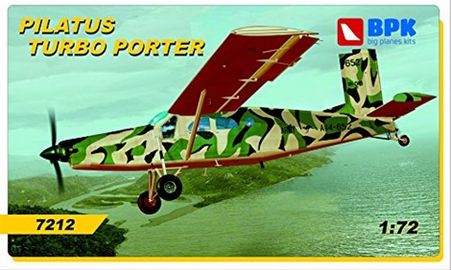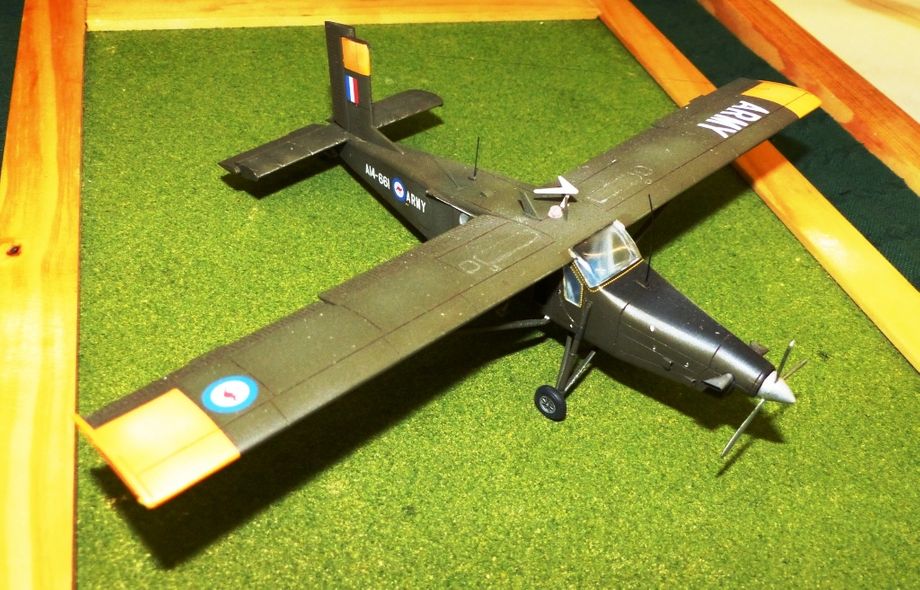BPK Turbo Porter
Subject Pilatus Turbo Porter
Manufacturer Big Planes Kits
Item No. 7212
Scale 1:72
Decal Options 4
Panel Lines Recessed
Materials Plastic, resin, etch, vinyl masks
Reviewer Geoff Cooper-Smith
In the box
The first thing to say about this kit is that it is a very comprehensive package indeed, the top opening box containing four sprues of grey plastic, one sprue of clear plastic, two frets of (uncoloured) etch, a resin casting block, a printed sheet of clear film, a set of vinyl masks, a decal sheet and a colour booklet of instructions.
The etch with clear film, resin and clear sprue are all in individual re-sealable bags for protection and placed in the same re-sealable bag containing the grey sprues. The instructions, decals (without a protective sheet) and masks are all in a little A5 ring binder sleeve. The A5 instruction booklet includes a parts layout, a 19 stage assembly sequence and a colour four view of each marking option. The colour call outs are for Gunze Enamels and Gunze Acrylics but there is no help with the colour(s) of the interior, or any other parts and you have to match the colours on the first page with those of the options on the back pages, which is going to be a pain once a marking option is selected.
The four grey sprues contain just over 100 parts, although not all will be needed as there are several alternatives, including both a three blade and four blade propeller (both slightly mal-formed in my kit) and what look like underwing chaff dispensers, which could be considered to be evidence of further boxings in the offing. The quality of both the moulding and the plastic appears high, although the surfaces could be a tad smoother. There are no locating pins for the major parts e.g. wing, fuselage, nor the plethora of small parts to be attached to the fuselage. There are however locating points for the undercarriage and tail plane.
The clear sprue contains separate parts for the windscreen, side windows and main cabin doors. The doors are moulded as a single piece and so just need to be masked off before painting.
The etch is most extensive; it contains a host of very small parts, including the instrument panel (with the printed film sandwiched in between), seat supports, wing fences, tail plane ends and a host of parts for sticking on the fuselage. There are no less than 36 etch parts to attach to the underside of the wing.
The resin block contains two different types of exhausts, replete with intricately moulded internals.
This kit offers markings for a pair of Australian Army machines, one in olive drab with high visibility additions in orange and one in a rather intricate 3-colour special camouflage scheme (and as seen on the box top) for the Caboolture air show in 1995. The other two options are for a pair of more recent Austrian machines, both in olive drab.
This is what I would call an ‘intermediate’ run kit, although the quality of the tooling and moulded detail looks beautiful, being worthy of a 1/48 scale kit. It is also thoughtfully laid out as injection points tend to be in ‘inaccessible’ locations, thus preserving the detail on show. It looks like the amount of etch will make it a challenge. I had intended to use the Turbo Porter option from my S&M British Antarctic Aviation decal sheet(SSM72-008), but research revealed that this was an early version with no 'front doors' to give direct access to the cockpit, so I reverted to one of the kit options.
The build
The first thing to note is the plastic, which although perfectly good to work with in terms of cutting, filing, sanding and (re)scribing, doesn’t seem to ‘react’ in the normal way with both solvent type and ‘superglue’ type adhesives. Consequently, seams parted regularly and apparently securely attached items would decide to detach themselves the following day.
The second thing to note is that despite the very comprehensive provision of alternative parts, the instruction sheet gives absolutely no guidance on which are required for the build. Research showed me the Australian version has the three bladed prop and that there is a sliding door on the starboard side and a pair of ‘suicide doors’ on the port side, necessitating removal of the slide rail moulded onto the fuselage and separation of the doors.
The cockpit is first and it immediately becomes evident why a second, smaller, etch sheet is included and that is because the instrument panel included on the main sheet is the wrong size! The instructions say to ‘balance’ the instrument panel on two ‘handle-bars’ affixed to the floor but I found there were two locating lugs moulded into the fuselage halves and so used these instead. And despite the apparently comprehensive etch, the really rather prominent belts for the cockpit seats are not provided and so these had to be made, and suitably detailed and painted, from lead foil. The worst aspect of the main cabin build is the fact that the only supports provided have to be made up from the etch and these are very flimsy, simply being unable to adequately support the plastic seats. Consequently, after a very frustrating evening of trying both the etch and scratch building these supports, I gave up and decided my example would have to be a ‘trash hauler’.
The side windows were masked for protection and installed prior to the fuselage halves being joined up, which go together pretty well, and just need a bit of sanding to hide the join, although the floor and rear bulkhead need quite a bit of trimming to ensure this. There is a separate under fuselage section which needs to be fitted and this needs a couple of sessions of filling and sanding to make it look like it should. Some of the panel lines don’t match up and so require correction. The nose is a separate construction and could well be from a different kit, even when the mating surfaces are cleaned and squared up. I found it best to install some plasticard tabs to hold it in place and ensure it remained secure for the many filling and sanding sessions which ensued. Both props had a deformed spinner which made rectification difficult and potentially perilous as the blades are integrally moulded. This is quite a delicate part and so attachment was left until weathering was complete.
The wing halves go together well, have good detail, commendably thin trailing edges and actually provide a good solid join with the fuselage, atop the cockpit. Again, some of the panel lines don’t match up and need correction. The flaps are separate and so I dry fitted these, left them off, painted separately and affixed at the end. This was followed by installation of the windshield which as usual I installed and then masked up to protect it until the build was complete. It fits OK at the top and sides but needed some filling and sanding at the base. The vinyl mask provided was pretty useless as it is too stiff to conform to the curvy nature of this part and so yellow kabuki tape was used instead.
The fit of the tailplanes was good although the tail fin needed the slot opening up for the locating tab to fit. The etch sheet really is an enigma as the tailplane end plates are most excellent, even having embossed detail, and most definitely an enhancement, but other parts, such as the rudder actuator, are so minute as to be virtually impossible to detach, fold and affix.
The main wheels comprise two halves with a separate outer hub fitted after painting, which gets a big thumbs up. The under carriage was prepared for assembly but left off, painted and not attached until the end.
Finishing off
The Australian air show camouflaged version is very intricate and would require a lot of masking, both the Austrian versions were really rather drab in appearance and not very inspiring and so it was decided to go for the Australian Army version in all over drab with dayglo red panels. With the transparencies still masked for protection from their fitting, gluing and filling, painting was relatively quick. The dayglo was done first following an undercoat of white and then ‘weathered down’ with a thin coat of white. After some easy masking (all straight lines) this was followed by the drab and some highlighting with slightly lightened and darkened mixtures of the same paint (all Gunze acrylics). It was noted from the images on the ‘tinterweb that Australian Turbo Porters appeared very well cared for and so highlighting and weathering was kept to a minimum. A coat of Gunze acrylic gloss followed and the whole thing left to harden for a few days as I find without this decal setting solutions can sometimes react with it and turn it a bit milky.
With this being a limited run kit and having been caught out too many times before i.e. decals disintegrating on contact with water, one of the markings from the other options was tested. With all appearing well, the model was duly decalled in one evening. Decal solutions were generally not required, apart from a light application to ‘shrink’ some of them into the recessed panel lines.
The undercarriage and flaps were then attached, along with the various aerials, the exhaust, propeller and lights, which had all been previously painted. The model then received a couple of light coats of matt varnish and a day-or-so later some very light weathering around key panels with a couple of shades of metallic pencils.
Finally, although the real thing has three quite prominent aerial wires, absolutely no help, or guidance was given in the instructions as to the location and attachment points for these. Consequently, I had to resort to the ‘tinterweb and thence add them with ‘stretchy thread’. With that the masking was removed from the transparencies and the thing was done and ready for the exhibition table.
The completed kit finally makes it onto the 580 table at Bolton 2020!
Should you?
Completing this kit to a satisfactory standard was a trial throughout, required several compromises and found to be occasionally infuriating. It would have been a lot easier if alternative parts had been provided e.g. seat supports, flap actuators, in plastic as well as etch. The etch itself would actually be worthy of a 1/32 scale kit in terms of its content and as a consequence I just didn’t bother with a lot of it as not only would it have severley tested the eyes and a steady hand, but make the finished model almost impossible to handle.
In conclusion I would say its only worth attempting this kit if you really want a 1/72 scale Turbo Porter, are willing to pay the close to £30 asking price, and have the time and patience so see it through. I for one will not be building another of this kit, ever.

